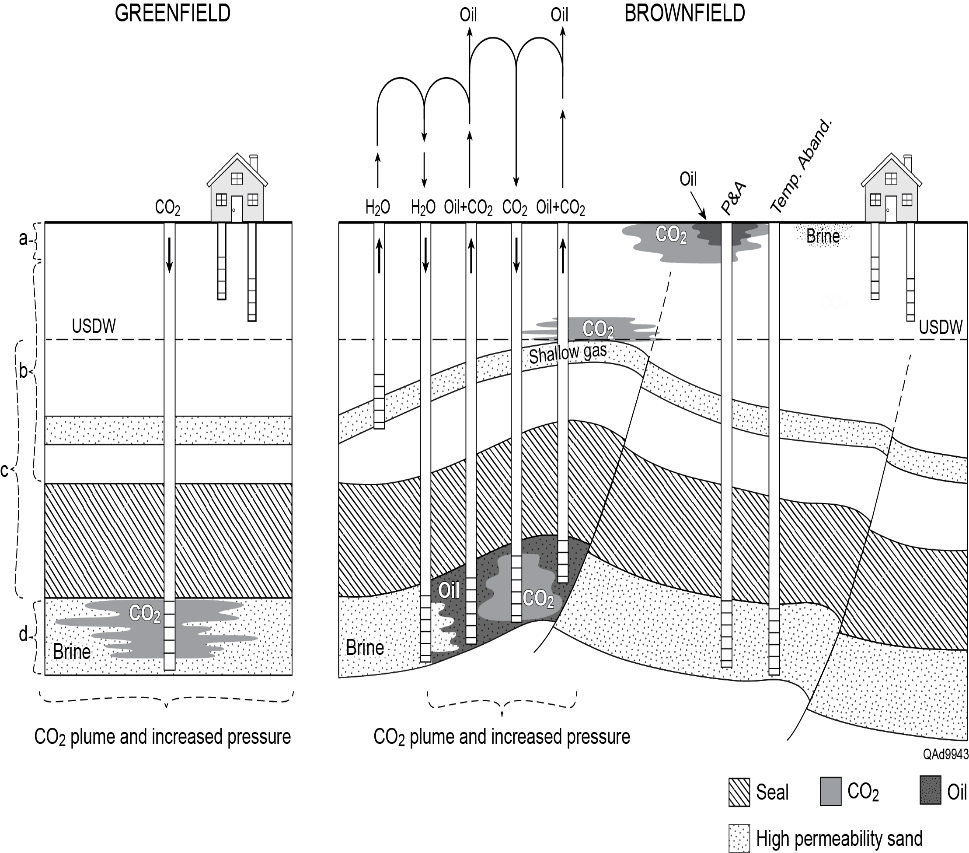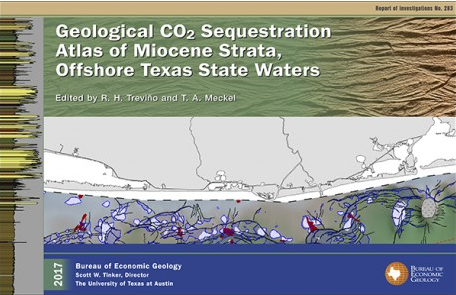Hastings Storage Project
Gulf Coast Carbon Center (GCCC) Researchers provided monitoring support of CO2 enhanced oil recovery (EOR) in South Houston, U.S.A.
2007–2011 Project Overview
The GCCC provided monitoring support to one of the first successful U.S. Department of Energy (DOE) sponsored industrial CO2 capture projects, entitled Recovery Act: Demonstration of CO2 Capture and Sequestration of Steam Methane Reforming Process Used for Large Scale Hydrogen Production (DE-FOA-0000015). Air Products captures approximately one million tons per year of CO2 at the Air Products hydrogen plant within the Valero Refinery in Port Arthur, Texas. Captured CO2 is transported via the Green Pipeline and used for enhanced oil recovery at the Hastings Field, which are both operated by Denbury Resources.
From 2010 to 2016, the GCCC assisted Denbury with design, execution, and assessment in regard to the effectiveness of the EOR operation retaining CO2. The GCCC led soil gas, groundwater, and above-zone pressure monitoring operations and further developed these techniques for commercial development. Additional work on 4D vertical seismic profiling (4D VSP) was led by Denbury, while the gravity part of the monitoring program as led by UT Dallas.
At Hastings Field, monitoring at the start-up of the CO2 EOR program provided substantive value to our increasing state of knowledge and readiness for additional commercial opportunities for storage. In particular, advances in understanding several aspects were made:
- Case study of expanding CO2 EOR areas for application beyond Paleozoic reservoirs of the Permian basin of Texas and New Mexico and Mesozoic basins in Mississippi. Gulf Coast sandstone reservoirs are thick, high porosity, high permeability, stacked with many prospective injection zones, and gas prone. Novel development of reservoir pattern development and monitoring techniques are needed.
- Case study of an injection site containing many faults. Hydrocarbon accumulation in Hastings field showed that the radial faults and crustal graben structure above a deep-seated fault dome are sealing. New techniques, however, are needed to conduct EOR and to monitor fault performance. Assessment of feasibility using thermal signal for monitoring fluid movement on faults (Ziedouni, 2014). Cross fault migration where sands are juxtaposed on sands in an adjacent fault block.
- Numerous well penetrations lower risk by providing dense information on the response of the subsurface to injection. Fluid (oil, CO2, and brine) extraction limits both the area and the magnitude of pressure increase as well as limiting the area where CO2 can migrate. Downdip water injection for pressure support can form a high pressure area that also limits CO2 migration. However in the converse many penetrations add to the risk of well completions that are not sufficiently isolating of the injection zone and allow migration either within a casing or in an unblocked casing-rock annulus. Migration can occur where no cement was emplaced, cement was damaged by physical or thermal stress. Fluids with dissolved CO2 migrating adjacent to cement have the potential to increase the aperture of a damaged zone and allow increasing transport of brine, hydrocarbons or CO2 to shallower zones that are not part of the EOR project and are in conventional production, to fresh water zones, or directly to the surface or air. Care in well preparation and surveillance of well performance has been effective in limiting losses from wells.
- Monitoring in an area of high complexity in fluids which has several implications that had not previously been considered.
- Previous oil and gas extraction techniques have likely left detectable traces of past subsurface fluids (brine and hydrocarbons) at the surface. It is important to separate these signals from any new fluids from depth as that
- Methane accumulations are observed in many zones from the injection reservoir to the deeper fresh groundwater zones in the Evangeline Aquifer. Under these conditions it is difficult to geochemically assess isolation/no migration of fluids from depth to shallow zones (Anderson 2017; Anderson et al. 2019). Adding to this concern are historical observations that hydrocarbon signals in soils are dynamic over time (Bertoni et al. 2018). It is possible that such complexities are common in hydrocarbon settings, in which case additional work is needed to understand the processes, rates, and mass transfer of fluids from depth to the surface. This is important to assure that rates are low and do not compromise storage; if that is true how can subtle trace signals be effectively separated from mass flux?
Large-scale expansion of the Air Products-Hastings type project in the Port Arthur, Texas region is feasible because this area hosts the largest oil refining capacity in North America (e.g. Exxon, Motiva, Valero, Total) and abundant storage opportunities via both CO2 EOR and deep saline aquifer storage.
Summary of Project Successes
Treviño, R.H., Hovorka, S., Dunlap, D.B., Larson, R.C., Hentz, T.F., Hosseini, S.A., Bhattacharya, S., DeAngelo, M.V., 2023, A Phased Workflow to Define Permit-ready Locations for Large Volume CO2 Injection and Storage: Greenhouse Gases: Science and Technology, v. 14, p. 95–110, https://doi.org/10.1002/ghg.2253.
Anderson, J., Romanak, K., Alfi, M., and Hovorka, S., 2019, Light Hydrocarbon and Noble Gas Migration as an Analogue for Potential CO2 Leakage: Numerical Simulations and Field Data from Three Hydrocarbon Systems: Greenhouse Gases: Science and Technology, v. 9, p. 226–244, https://doi.org/10.1002/ghg.1841.
Anderson, J., 2017, Compositional changes of light hydrocarbons during migration through overburden: Proxy for assessing potential leakage from Geological Carbon Storage: PhD Dissertation, The University of Texas at Austin, 144 p., http://hdl.handle.net/2152/63852.
Karegar, M.A., Dixon, T. H., Malservisi, R., Yang, Q., Hosseini, S. A., Hovorka, S.D, 2015, GPS-based monitoring of surface deformation associated with CO2 injection at an enhanced oil recovery site, International Journal of Greenhouse Gas Control, v.41, p. 116–126, https://doi.org/10.1016/j.ijggc.2015.07.006.
Zeidouni, M., Nicot, J. -P., and Hovorka, S. D., 2014, Monitoring above-zone temperature variations associated with CO2 and brine leakage from a storage aquifer: Environmental Earth Sciences, v. 72, no. 5, p. 1733-1747,
http://doi.org/10.1007/s12665-014-3077-0.
Davis, D., Nuñez, V., Hovorka, S. D., Wolaver, B. D., Hosseini, S. A., Porse, S., Romanak, K., 2013, Final Report for the MVA Construction Phase Phase 2B at West Hastings Field, Gulf Coast Carbon Center at the Bureau of Economic Geology, a unit of The University of Texas at Austin, final report, prepared for Air Products and Chemicals, Inc., DOE award number DE-FE-0002381.
Wolaver, B. D., Hovorka, S. D., and Smyth, R. C., 2013, Greensites and brownsites: Implications for CO2 sequestration characterization, risk assessment, and monitoring: International Journal of Greenhouse Gas Control, v. 19, p. 49–62, http://dx.doi.org/10.1016/j.ijggc.2013.07.020.

Student Achievements
Anderson, Jacob - 2017 Geological Sciences Dissertation: Compositional changes of light hydrocarbons during migration through overburden: Proxy for assessing potential leakage from Geological Carbon Storage (download). Advised by Michael Young.
Porse, Sean - 2013 Geological Sciences Master’s Thesis: Using Analytical and Numerical Modeling to Assess Deep Groundwater Monitoring Parameters at Carbon Capture, Utilization, and Storage Sites (download). Advised by Michael H Young.
Manuscripts Related to the Pulse-Testing Idea at Hastings
Shakiba, M., and Hosseini, S. A., 2016, Detection and characterization of CO2 leakage by multi-well pulse testing and diffusivity tomography maps: International Journal of Greenhouse Gas Control, v. 54, p. 15–28, http://doi.org/10.1016/j.ijggc.2016.08.015.
Hosseini, S. A., and Alfi, M., 2016, Time-lapse application of pressure transient analysis for monitoring compressible fluid leakage: Greenhouse Gases: Science and Technology, v. 6, p. 352–369, http://doi.org/10.1002/ghg.1570.
Last Updated: April 28, 2025



